Physical Address
304 North Cardinal St.
Dorchester Center, MA 02124
The complex architecture of the human body requires an efficient life-support system that transports gases, liquids, and other nutrients as well as circulating cells that play important roles in body defense systems. These interacting tasks are carried out by a system that is ubiquitous to all vertebrates and comprises two treelike branched systems of tubules known as blood and lymphatic vessels lined by highly specialized endothelial cells. These two tubular systems are connected through a large lymphatic vessel, which drains the lymph fluid to the blood circulation and is referred to as the thoracic duct . The dysfunctions and malformations of these systems contribute to the pathogenesis of many human diseases and frequently give rise to tumors and tumorlike malformations in the skin, soft tissue, and viscera. In bone, the nutrient arteries penetrate the cortex and branch into an abundant network of small arteries and capillaries. The rich capillary network in the medullary cavity is drained to efferent venules and veins. The periosteal vessels supply the outer portion of the cortex. Communication between the periosteal and medullary vasculature is provided by anastomotic vessels within Volkmann's and haversian canals. A rich network of periosteal lymphatics is present. The presence of medullary lymphatics can be best documented in abnormal conditions of lymph stasis. Despite the rich vascularity of bone, skeletal vascular lesions are rare, and consequently knowledge of their clinical and pathologic features is still limited.
Solitary hemangiomas are the most common vascular lesions of bone. Angiomatoses occur less frequently than solitary hemangiomas. The clinical behavior and the extent of skeletal involvement by angiomatoses provide a means of descriptively dividing them into regional versus disseminated and nonaggressive versus aggressive forms. Skeletal angiomatoses typically present in two distinct clinical settings: disseminated skeletal angiomatosis, sometimes referred to as cystic angiomatosis, and massive osteolysis (Gorham's disease). Malignant vascular tumors of bone occur less frequently than hemangiomas. Their behavior ranges from that of indolent, low-grade tumors, such as epithelioid hemangioendothelioma, to that of lethal, high-grade angiosarcomas or hemangiopericytomas. The classification of malignant vascular lesions is still in a state of flux, and controversy continues about the biologic potential of those tumors currently designated as low-grade or borderline endothelial tumors. The situation has been further complicated by the human immunodeficiency virus (HIV) pandemic and its associated vascular lesions in bone, such as bacillary angiomatosis and Kaposi's sarcoma.
The most significant developments contributing to our knowledge of vascular lesions stem from molecular biology, which provides new information on the molecular mechanisms controlling vascular growth and differentiation.
In brief, vascular endothelial growth factor-A (VEGF-A), which is a part of a large superfamily of growth factors, is required for differentiation of endothelial precursor cells. The sprouting of endothelial cells is regulated by Notch signaling receptors and their Delta-like 4 (DLL4) ligand. Precurser lymphatic endothelial cells form a distinctive cluster in mid-gestation embryos on the dorsal side of the jugular vein. The prospero related homeobox-1 (PROX1) transcriptional factor and vascular endothelial growth factor receptor-3 (VEGFR3) are responsible for their differentiation into lymphatic endothelial cells. Although endothelial cells of blood vessels and lymphatics are somewhat similar, the lymphatics lack a continuous basement membrane and are not tightly sealed by intercellular junctions, permitting the free access of interstitial tissue fluid into the vessel. Each component of both vascular and lymphatic systems has its own expression signature. For example, the arterial gene expression signature involves VEGFA, VEGFR2, neuropilin-1 (NRPI), forkhead box protein C1 or C2 (FOXC1/2), Notch signaling, and ephrin-B2; the venous expression signature includes the COUP transcription factor 2 (COUP-TFII), Notch signaling, and ephrin-B4.
From the diagnostic point of view, these investigations have provided us with a new generation of markers identifying endothelial phenotypes useful in differential diagnosis of vascular lesions. The standard vascular markers used in pathologic differential diagnosis of vascular conditions include von Willebrand factor (vWF), factor VIII-associated protein, platelet endothelial cell adhesion molecule-1 (CD31), human hematopoietic progenitor cell antigen (CD34), v- ets avian erythroblastosis virus E26 oncogene homolog (ERG), human herpes virus 8 (HHV-8), latency-associated nuclear antigen (LANA1), podoplanin (D2-40), and PROX1.
Factor VIII-associated protein is historically the first immunohistochemical marker of endothelial cells. vWF is least sensitive of the vascular markers and is present in only 50% to 70% of vascular tumors.
The CD31 marker, an adhesion molecule for platelets, is one of the newer markers of endothelial cell differentiation and is considered to be among the most specific and sensitive markers in the differential diagnosis of vascular tumors. It is believed to be expressed in more than 90% of vascular tumors. It can occasionally be expressed in carcinomas but the expression is very weak and focal. It is consistently expressed in high levels in tumor macrophages.
The transmembrane glycoprotein (CD34) is not entirely specific for endothelial cells; it is also expressed on hematopoietic cells, the interstitial cells of Cajal, dermal dendritic cells, and nerve sheaths. It is also present in several soft tissue tumors such as dermatofibrosarcoma protuberans, solitary fibrous tumor, gastrointestinal stromal tumor, and epithelioid sarcoma among others.
The ETS family of transcription factors play an important role in the pathogenesis of several bone and soft tissue tumors as fusion partners of chimeric genes. Ewing's sarcoma is a prototypic tumor exhibiting a translocation resulting in the EWSR1-FLI1 fusion gene present in nearly 80% of these tumors. The ERG gene is a rare partner of this fusion, seen in less than 10% of Ewing's sarcomas. It has been recently shown that it is a major partner in the TMPRSS2-ERG fusion gene, present in approximately 50% of prostatic adenocarcinomas. Both FLI1 and ERG are expressed by endothelial cells and are positive in nearly 95% of vascular tumors of all types. ERG is currently considered one of the best markers of endothelial differentiation.
The identification of the specific herpes virus HHV-8 and its associated antigens as markers of Kaposi's sarcoma has facilitated their use in the differential diagnosis of vascular endothelial proliferations. LANA1 is particularly useful because it is present as a nuclear protein in all forms of Kaposi's sarcoma.
Podoplanin (D2-40) is a transmembrane glycoprotein expressed by lymphatic endothelial cells. It is also expressed in glomerular podocytes, choroid plexus epithelium, type 1 alveolar cells, osteoblasts, and mesothelial cells. Its expression is regulated by PROX1, and both proteins are considered to be markers of lymphatic endothelial cells, but as with many other markers, they are not fully specific for lymphatic endothelial cells.
Lectin proteins such as Ulex europaeus, frequently used in the past, are rarely used as markers of endothelial cells in modern diagnostics.
Recently, genome sequencing has identified a new class of chromosomal translocation (1;3)(p36;q25) resulting in a WWTR1-CAMTA1 gene fusion that appears to be specific for epithelioid hemangioendothelioma regardless of its site of origin, including those that arise in the skeleton.
Hemangioma is a benign solitary tumor composed of newly formed vessels of capillary or cavernous types.
The peak age incidence and most common sites of skeletal involvement are shown in Figure 13-1 . Hemangiomas of bone are rare lesions, accounting for less than 1% of all primary tumors of bone. The identification of skeletal hemangiomas of vertebral bodies in more than 10% of autopsies, however, indicates that they occur more frequently. A significant number of solitary skeletal hemangiomas are asymptomatic and are never diagnosed during life. It should be anticipated that increasing the use of magnetic resonance imaging, particularly for symptoms of back pain, should increase the frequency of incidentally diagnosed hemangiomas of bone. Hemangiomas have a wide age distribution, ranging from the first to eighth decades of life, with nearly 70% of cases diagnosed in patients between ages 30 and 60 years. Occasionally, hemangiomas become clinically evident during the first decade of life. There is no clear sex predilection, but in some series, female patients are slightly more frequently affected than male patients.
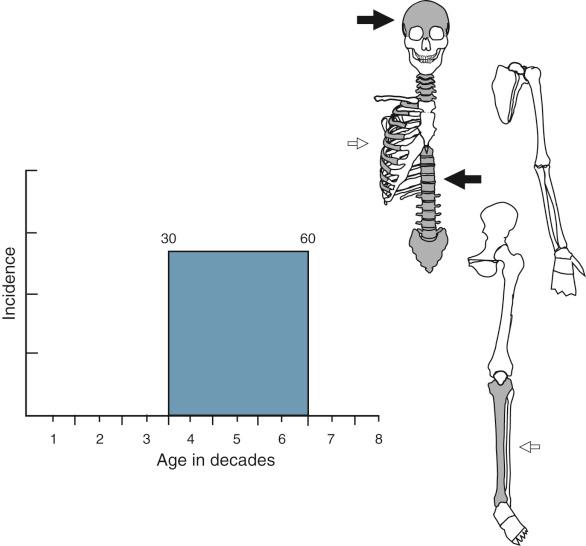
Hemangiomas frequently occur in the craniofacial bones, predominantly in the calvarium, and in some series nearly 50% of the lesions occur at this site. The spine is involved in approximately 20% of cases. On the other hand, if autopsy data on asymptomatic lesions are included, the vertebral bodies represent the most frequent site of involvement by hemangioma. The major long tubular bones are the bones of the appendicular skeleton most frequently involved. Hemangiomas can be multifocal. The small multifocal lesions are most frequently identified in the vertebral column involving adjacent vertebral bodies.
Radiographically, hemangiomas present as lucent, well-demarcated defects. In flat bones, they markedly expand the bone contour and produce rarefaction with radially oriented striations ( Fig. 13-2 ). The vascular nature of the lesion is often suggested by its bubbly or honeycomb, trabeculated appearance ( Figs. 13-3 to 13-5 ). The overlying cortex is expanded and thinned, but complete cortical disruption and invasion into soft tissue are not present. The characteristic sunburst appearance of hemangioma is seen in skull lesions ( Fig. 13-2 ) and is produced by fine spicules of reactive new bone in the periosteum radiating outward from the center of the lesion. The sunburst type of periosteal new bone formation should not be confused with that seen in association with osteosarcoma of long bone. Smaller lesions may present as intracortical rarefactions with or without a honeycomb appearance and adjacent sclerosis ( Fig. 13-6 ). They can mimic benign osteoblastic lesions (osteoid osteoma, osteoblastoma) radiographically. Some hemangiomas are purely lytic lesions with sharply demarcated borders and should be differentiated from cystic lesions ( Fig. 13-7 ). Rarely a hemangioma may present as a subperiosteal lesion ( Fig. 13-8 ). Magnetic resonance imaging of hemangiomas generally reveals a low signal on T1-weighted images and a high signal on T2-weighted images. The latter is explained by the fluid content of tumor vessels. In vertebral body hemangiomas, the loss of hematopoietic cells in the interstices of hemangiomas and apparent increase in fat can produce a high signal in T1-weighted images.
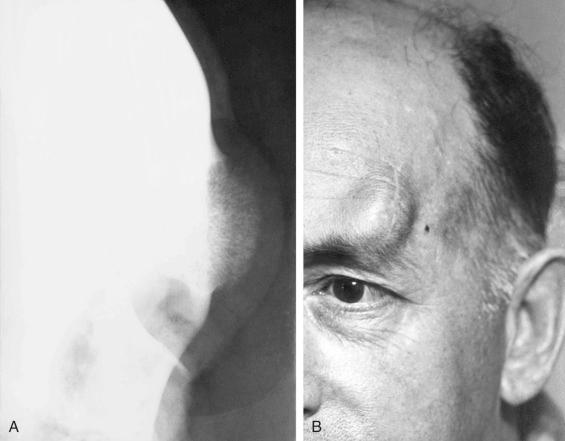
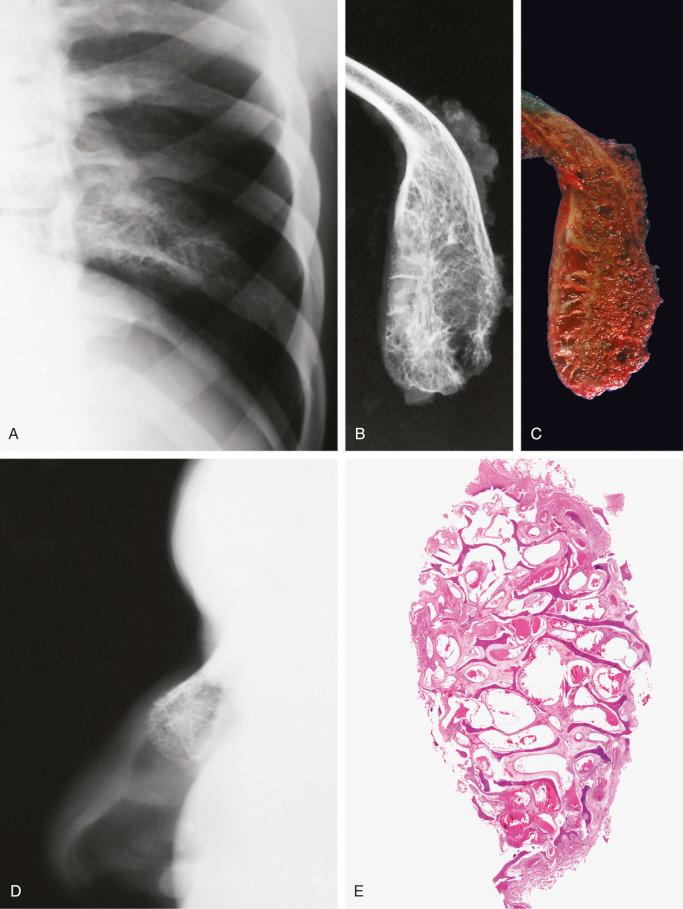
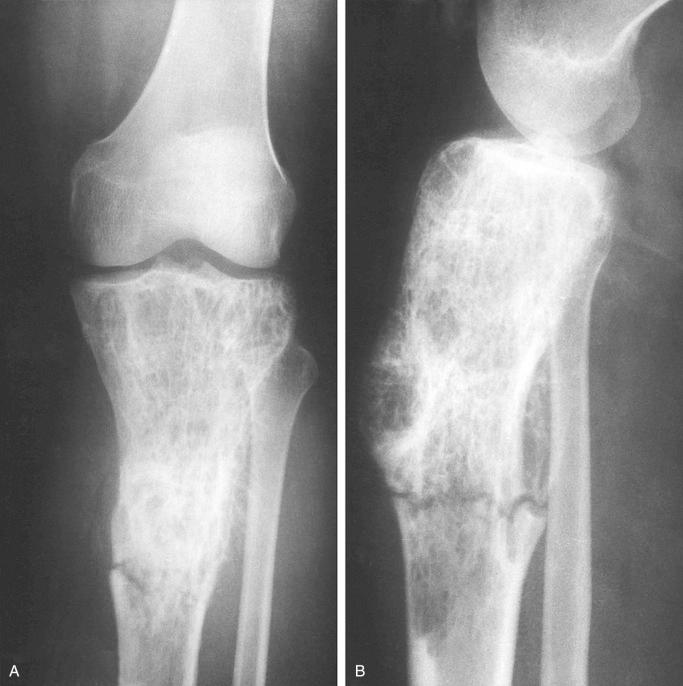
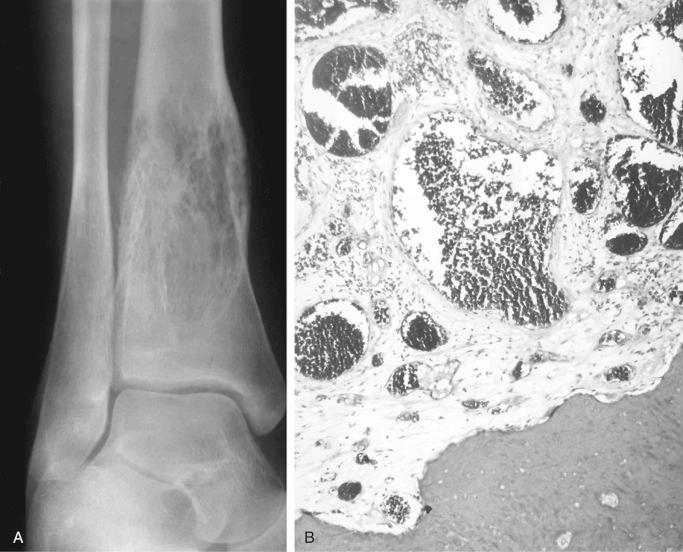
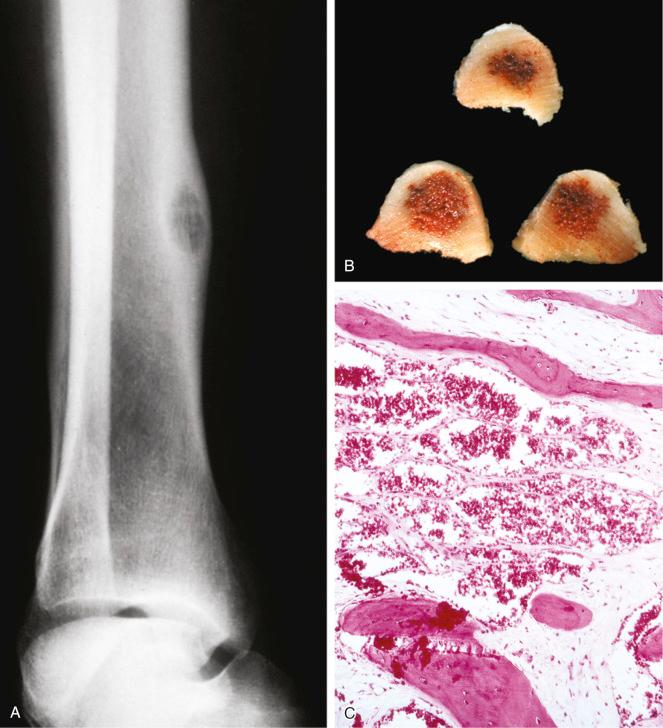
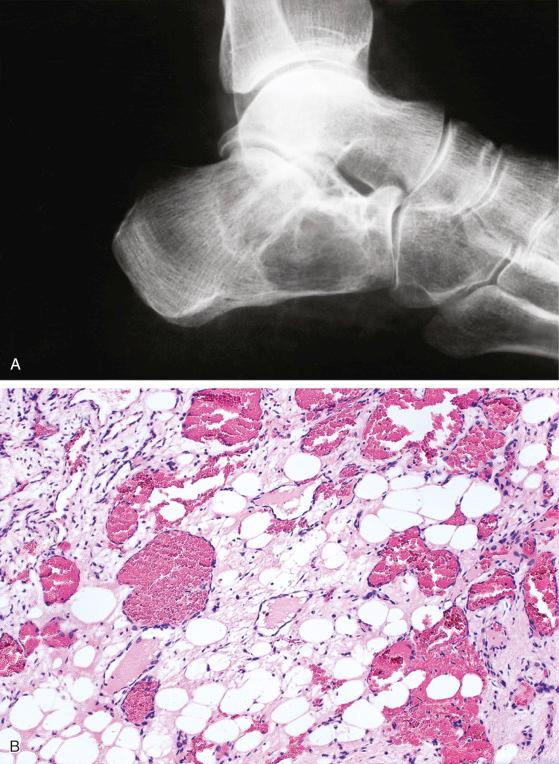
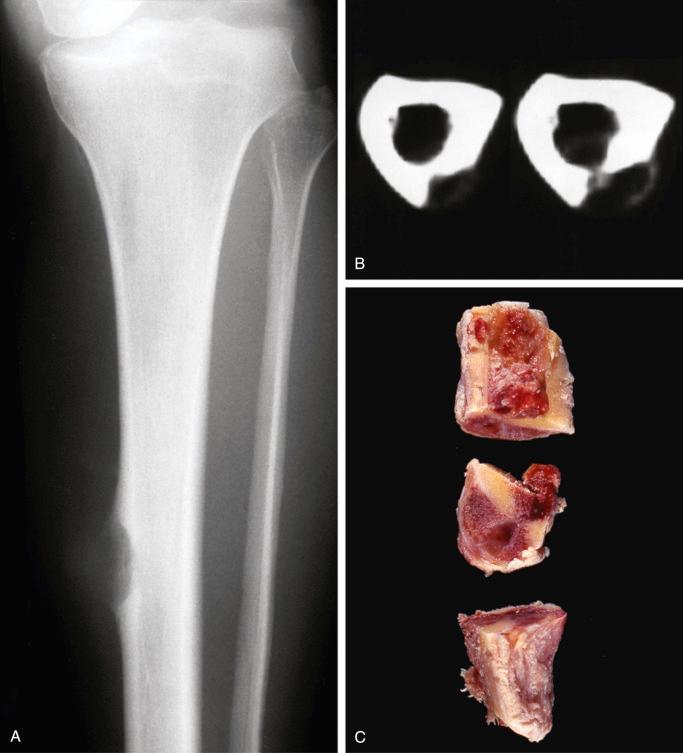
Hemangioma presents as a brown-red or dark red, well-demarcated, medullary lesion. Occasionally, it can be intracortical or subperiosteal ( Fig. 13-8 ). It may have a honeycomb appearance with sclerotic bone trabeculae interspersed among hemorrhagic cavities. Some hemangiomas provoke an abundance of reactive bone and appear more sclerotic ( Fig. 13-6 ). Some lesions are composed exclusively of vascular tissue and contain no bone. Perpendicular periosteal new bone formation and the radiating spicules can be seen on the surface of some of the resected hemangiomas ( Fig. 13-3 ).
Hemangiomas are composed of a conglomerate of thin-walled blood vessels. The vessels can have dilated open channels (cavernous hemangioma) or, less frequently, may be composed of capillary-sized vessels (capillary hemangioma) ( Figs. 13-9 to 13-12 ). A majority of bone hemangiomas are of cavernous or mixed types (cavernous and capillary). Predominantly or exclusively capillary hemangiomas are exceedingly rare in bone. The size of cavernous vessels may vary, but occasionally hemangioma can be composed of vessels that are relatively uniform in size ( Fig. 13-9 ). The vascular channels are lined by a single layer of flat endothelial cells ( Figs. 13-7 and 13-9 ). Occasionally, these cells can have plump cytoplasm and even epithelioid features ( Fig. 13-10 ). The intercellular tissue is composed of loose connective tissue that may exhibit myxoid change. The cancellous bone in the affected area can be completely resorbed. In such cases, the lesion is composed of vessels and stromal tissue, but more often, some residual trabeculae of cancellous bone are present. These trabeculae are usually thickened. Some hemangiomas may cause pronounced sclerosis of the intralesional and adjacent bone. The vascular channels of hemangioma are complete, are separate, and do not show an anastomosing pattern. In vertebral body hemangiomas, the blood-forming elements may be lost completely in the interstices, leading to an unmasking of adipose tissue. This apparent increase in fat in the interstitial tissue of vertebral hemangiomas can be quite prominent.
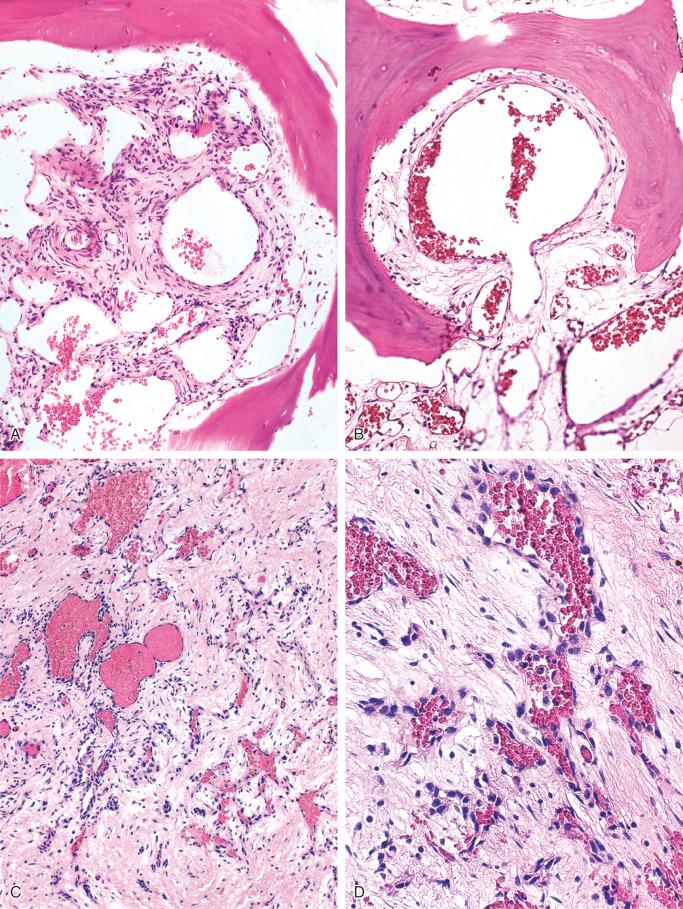
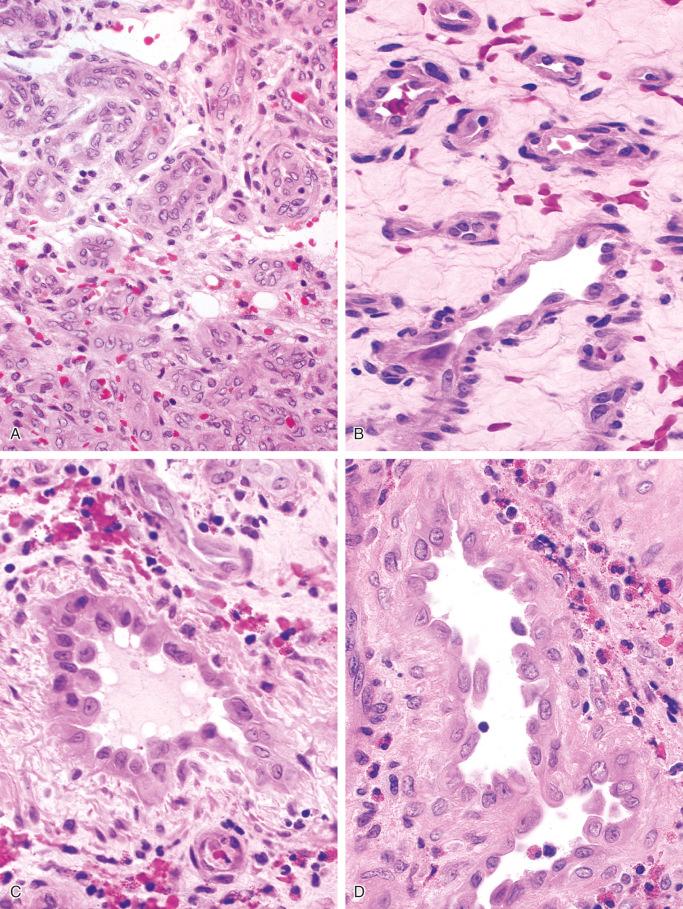
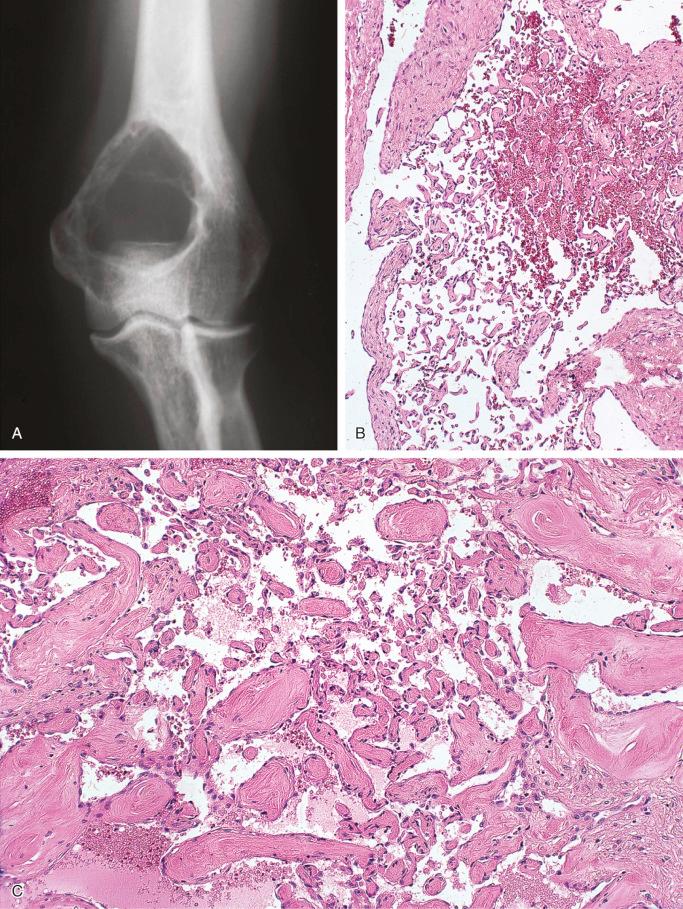
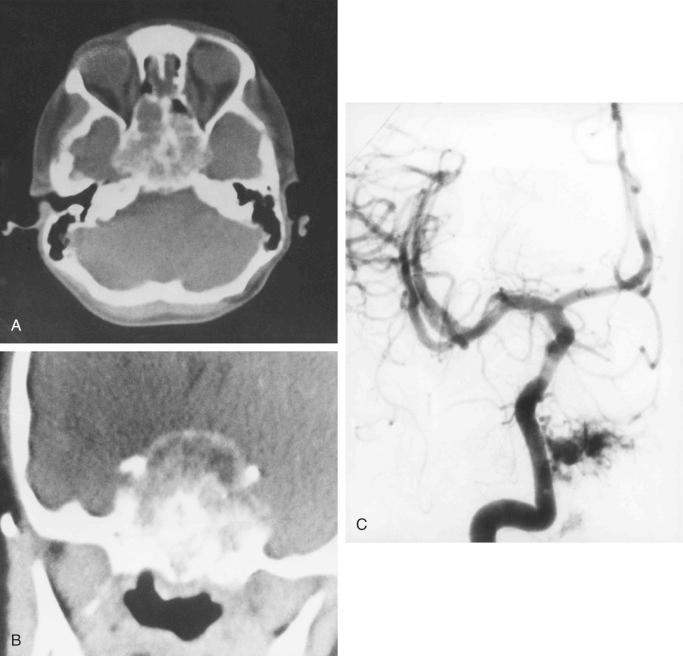
Hemangiomas have a characteristic microscopic appearance and in the majority of cases are easy to recognize. However, secondary changes may alter this classic pattern and make the diagnosis difficult. Hemangiomas of any type, but especially those with large cavernous vessels, occasionally develop thromboses with calcifications. This in turn can promote the development of papillary endothelial hyperplasia ( Fig. 13-11 ). The presence of this change can alter the pattern of vascular channels and lead to the misdiagnosis of a malignant vascular tumor. Papillary endothelial hyperplasia was described by Masson in 1923 under the term hemangioendotheliome vegetant intravasculaire. It can occur in any part of the body involving blood vessels or soft tissue hemangioma or can be superimposed on a preexisting vascular tumor. Most frequently, it presents as a small mass in the skin and superficial soft tissue. It is less common in vascular lesions of bone. Papillary endothelial hyperplasia may be so abundant that it tends to obscure the underlying hemangioma, or it may be found only in focal areas. Papillary proliferations of plump endothelial cells with central fibrin or hyaline cores typically are seen. Microscopic examination at low power is extremely important because this magnification allows visualization of the papillary structures within preexisting vascular spaces and the pattern of progression toward the center of the vessel. Similar orientation can be seen if the lesion develops in a focus of hemorrhage. Under high power magnification, cross-sectioned papillary structures appear to be floating in the vascular lumina. The spaces between them can form a network that simulates anastomosing channels, which together with the presence of plump endothelial cells, can be misinterpreted as the vascular pattern of angiosarcoma. Fibrin with calcified cores may be present. Calcified spherical structures sometimes mimic psammoma body–like structures or cementoid bodies. Various phases of organization in the thrombotic material also are present and are associated with an inflammatory cell infiltrate. In rare instances, aneurysmal bone cyst can be superimposed on a preexisting hemangioma.
This variant of hemangioma affecting bone has been more frequently diagnosed in recent years, and its similarity to corresponding lesions occurring in soft tissue has been recognized. Its biologic potential is still not entirely clear, as indicated by a recently reported case with regional lymph node involvement. Moreover, a study of 17 vascular tumors of bone suggested that epithelioid hemangioma could not be separated from epithelioid hemangioendothelioma, and that rather than representing a distinct benign entity, epithelioid hemangioma is part of the spectrum of hemangioendothelioma of bone. Clearly, as of this writing, the place of epithelioid hemangioma in the nosology of vascular tumors, especially those involving the skeleton, remains controversial. The recent identification of the t(1;3)(p36;q25) and WWTR1-CAMTA1 fusion in epithelioid hemangioendothelioma should help to resolve this controversy but the experience with bone lesions is limited.
An epithelioid change of endothelial cells lining the vessels of hemangioma (epithelioid hemangioma) can cause this benign vascular lesion to be misdiagnosed as an epithelioid hemangioendothelioma. Epithelioid hemangioma is basically a benign hemangioma with plump and somewhat more active endothelial cells ( Fig. 13-10 ). Other features, such as solid or cordlike proliferations of endothelial cells and the anastomosing vascular pattern characteristic of epithelioid hemangioendothelioma, are not present. The presence of prominent spindle-cell elements and hemorrhage rarely complicate the histologic diagnosis.
Epithelioid hemangioma as a distinctive neoplasm was originally described as angiolymphoid hyperplasia with eosinophilia and subsequently as inflammatory angiomatoid nodule, pseudopyogenic granuloma, or histiocytoid hemangioma. It is somewhat similar to but pathogenetically distinct from the lesion designated as Kimura's disease. Some epithelioid hemangiomas are rather reactive and are seen in association with an injured vessel. Hemangiomas with epithelioid change in bone have no apparent relationship to angiolymphoid hyperplasia with eosinophilia or Kimura's disease. Therefore the term epithelioid hemangioma in bone should be used in a descriptive sense only. The radiologic features of bone hemangiomas and epithelioid hemangiomas often overlap, and their radiographic differentiation is, in such instances, not possible.
The flat endothelial cells lining the capillary or cavernous vascular channels of hemangiomas can be easily distinguished from the plump, enlarged endothelial cells of hemangioendotheliomas . Individual lesions of skeletal angiomatosis are histologically identical to those of solitary bone hemangiomas; the distinction is based on the mult-centric distribution of angiomatosis. Epithelioid hemangiomas can be confused with a low-grade epithelioid hemangioendothelioma . However, other diagnostic features of epithelioid hemangioendothelioma—solid nest or cords of endothelial cells and an anastomosing pattern of irregular vascular channels—are not present in a benign hemangioma with epithelioid change.
Asymptomatic small hemangiomas require no treatment; some may even undergo spontaneous regression. Symptomatic lesions or those that are large and may cause pathologic fracture or vertebral collapse require treatment. Curettage and bone grafting usually is sufficient. Symptomatic vertebral lesions are treated by decompression laminectomy; radiotherapy may be added to curettage. Surgically inaccessible hemangiomas may be treated by radiotherapy alone. Transarterial embolization, vertebrectomy, and vertebroplasty have become widely used in the management of symptomatic vertebral hemangiomas. Hemangiomas of the cranial vault and those of the facial bones are usually treated by en bloc excision.
Hemangiomas involving different parts of the skeleton present unique radiographic and pathologic characteristics. In addition, the lesions in different skeletal sites present distinct diagnostic problems and can present with different clinical features. For these reasons, separate descriptions of hemangiomas in various anatomic sites are provided.
The craniofacial bones are frequent sites of involvement by hemangiomas, which typically occur in the frontal area of the cranial vault ( Fig. 13-2 ). Hemangiomas at this site present with a sunburst effect of radiating bone spicules that extend from the center of a lucent defect. The shape of the defect is circular in an en face view and ellipsoid in a lateral view. Occasionally the typical honeycomb appearance can be seen in craniofacial lesions ( Fig. 13-3, D ). Hemangiomas of the skull produce a convex surface bulge of the cortex externally. Expansion of the inner concave surface with signs of increased intracranial pressure is rare but was observed in two cases in our series. Hemangiomas very rarely involve the base of the skull ( Fig. 13-12 ). Microscopically, hemangiomas of the craniofacial bones, especially those of the skull, are cavernous and show more abundant interstitial connective tissue than vertebral hemangiomas. The most striking feature is the presence of prominent trabecular bone between the engorged vascular elements. Rarely, aneurysmal bone cyst can be superimposed on a preexisting calvarial hemangioma.
The involvement of vertebral bodies, especially of the lower thoracic and lumbar regions, is typical for hemangiomas ( Figs. 13-13 and 13-14 ). There is a disparity between the frequency of finding vertebral hemangiomas during autopsies and their relatively rare clinical significance. Many vertebral hemangiomas are asymptomatic. They either are too small or do not disrupt the trabecular architecture sufficiently to be visualized on plain radiographs. Symptomatic hemangiomas of the vertebral column are usually diagnosed in patients older than age 40 years.
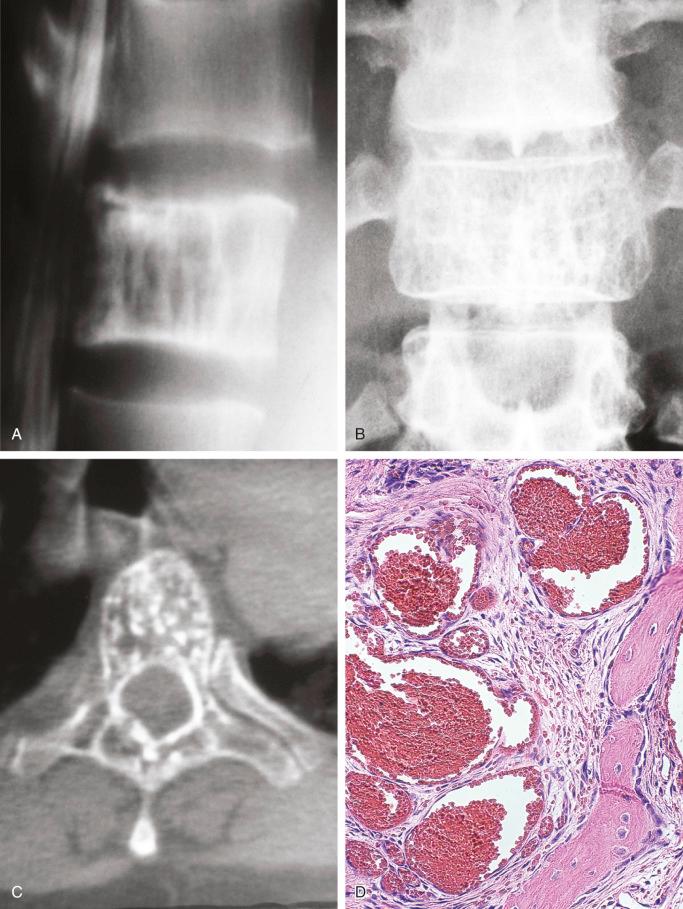
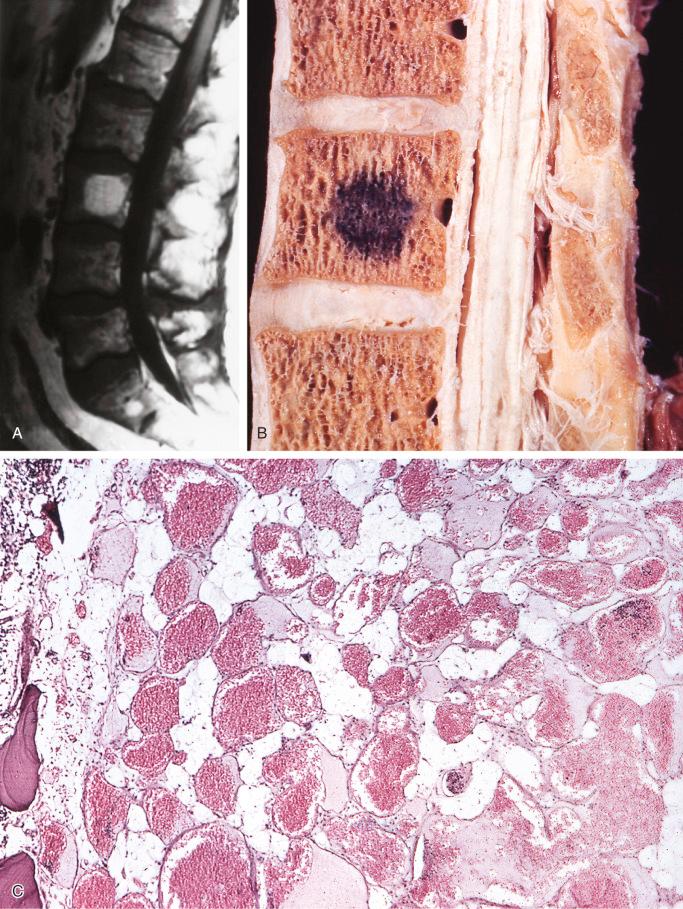
Vertebral hemangiomas that produce clinical symptoms are usually associated with back pain and muscle spasm followed by an acute episode of severe pain and neurologic symptoms of spinal cord compression. The lesion is usually associated with collapse of the vertebral body or bulging cortex that compresses the spinal cord or nerve roots.
Vertebral hemangiomas appear on radiographs as areas of rarefaction traversed by the thickened vertical bone trabeculae, which give them a striated or corduroy-like appearance ( Fig. 13-13 ). The majority of lesions in this location measure less than 1 cm. Large lesions can occupy the entire vertebral body and expand its contour. Findings on axial computed tomograms are very characteristic because of the polka-dot appearance of thickened vertical trabeculae seen on end ( Fig. 13-13 ). T1-weighted magnetic resonance imaging clearly demonstrates the lesion as a well-demarcated area of high signal as a result of the apparent increase of fat. Magnetic resonance imaging occasionally reveals evidence of associated involvement of soft tissue. T2-weighted images show an area of high signal. An interesting relationship has been noted between pregnancy and the development of clinical signs of spinal cord compression by vertebral hemangiomas. The mechanism of the phenomenon is unclear and can be related to increased venous pressure in the paravertebral plexus or can be the result of an increased growth rate of hemangiomas during pregnancy. Symptomatic hemangiomas of the vertebral column are treated by surgery (spinal cord decompression), radiotherapy, or both.
Hemangiomas that involve bones other than the vertebrae or skull are very rare and usually occur in the bones of the lower extremity and ribs; however, any bone can be involved ( Figs. 13-3 to 13-8 ). Hemangiomas that involve long bones can reach considerable size before they become symptomatic ( Figs. 13-4 and 13-5 ). Consequently, lesions of the long tubular bones are usually larger than those of the skull and vertebral bodies. They involve the metaphyseal and diaphyseal parts of long tubular bones and present radiographically as lytic areas with bone trabeculation creating a soap-bubble or honeycomb appearance as a result of the expansive proliferation of engorged vessels and thickened, remodeled bone trabeculae. Expansion of the bone contour with thinning of the cortex is frequently seen. Spiculated periosteal reaction may be present. Long bone hemangiomas are rarely diagnosed correctly preoperatively, and they are often misdiagnosed radiologically as malignant lesions. Hemangiomas that involve the flat bones, such as the pelvis and scapula, are rare and have the same sunburst appearance as the calvarial lesions. In extremely rare cases, hemangioma can present radiographically as an intracortical lesion and mimic other intracortical lesions that occur more frequently, such as osteoid osteoma and abscess ( Fig. 13-6 ). Hemangioma can also present as a subperiosteal lesion ( Fig. 13-8 ).
The diagnosis of craniofacial and vertebral hemangiomas on the basis of clinical and radiographic features usually presents little difficulty, but large hemangiomas of long bones may raise the suspicion of a malignant bone tumor because of the prominent perpendicular pattern of reactive new bone in the overlying periosteum. Intracortical hemangiomas in long bones have been mistaken for osteoid osteoma and even for adamantinoma before biopsy because of their features on radiographs. Benign hemangiomas of bone with secondary changes (epithelioid or superimposed papillary endothelial hyperplasia) are frequently overdiagnosed as malignant vascular neoplasms. Vertebral hemangiomas can present diagnostic problems when both the centrum and posterior elements are involved and there is associated soft tissue involvement, with extradural impingement.
Although borderline vascular tumors involving bone are relatively rare, few clinicopathologic entities have engendered more controversy in the literature than epithelioid hemangioendothelioma of bone and epithelioid hemangioma. As stated before, the identification of the specific translocation in epithelioid hemangioendothelioma should help to resolve this long-lasting controversy as preliminary data indicates that epithelioid hemangiomas are negative for this abnormality. However, validation of this concept in a significant number of bone cases is not available in the literature at the time of this writing.
Lymphangioma represents a benign lesion composed of newly formed lymph vessels, in the form of dilated cystic spaces. They are usually diffuse or multiple and most likely represent hamartomatous malformations rather than true neoplasms. Solitary lymphangiomas occur less frequently, and only single cases have been reported in the literature. Dilated intraosseous lymphatics can also present in association with lymph stasis. Multiple lymphangiomas of the ribs can be associated with chylothorax or chylopericardium. Lymphangiomatosis of bone can be associated with soft tissue (extraskeletal) lymphangioma.
Microscopically, lymphangioma or lymphangiomatosis consists of dilated, thin-walled vessels filled with proteinaceous fluid that has no blood elements ( Fig. 13-15 ). It may be difficult to distinguish between blood and other lymphatic spaces when the contents have been lost during tissue processing. Often a mixture of lymphatics and blood vessels can be present in one lesion. Immunohistochemical stains may help to identify the lymphatic nature of vessels in both lymphangioma and lymphangiomatosis. The putative markers of lymphatic endothelial differentiation are: VEGFR-3, podoplanin (D2-40), and PROX1. However, none of these markers is entire specific for lymphatic endothelial cells and are expressed to some degree in nonlymphatic vascular tumors as well as in tumors of nonvascular origin. Lymphangiomatosis predominantly occurs in children and rarely becomes manifest after age 20 years. Diagnosis at birth is uncommon; a latent period is required for lesions to achieve sufficient size to become symptomatic. The lesion can also occasionally present as a pathologic fracture, especially in the long bones.
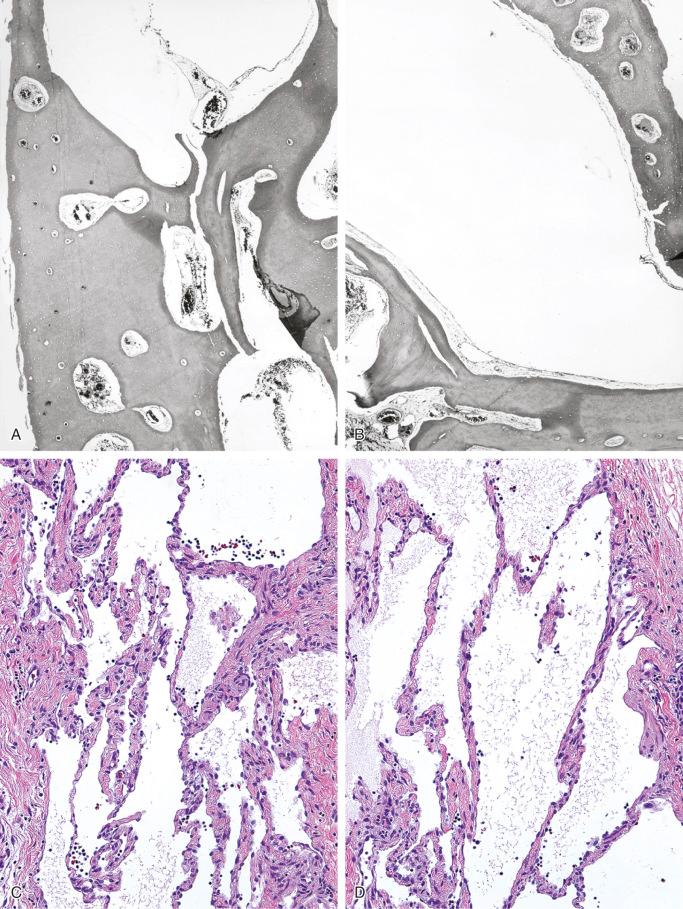
On radiographs lymphangiomatosis can show pronounced expansion of large affected areas of the entire bone with sunburst periosteal reaction ( Figs. 13-16 and 13-17 ). The lesions seem to be composed of multiple coalescent lytic areas separated by thin sclerotic zones. The use of lymphangiography helps establish the nature of the lesion before biopsy. The overall prognosis is good, unless there is significant visceral involvement. The lesions eventually stabilize and sclerose, but the profound bone deformity, if present, persists. Some cases of lymphangiomatosis of bone can pursue an aggressive clinical course with progressive bone loss (massive osteolysis) and may have radiographic features of disseminated generalized disease (cystic angiomatosis).
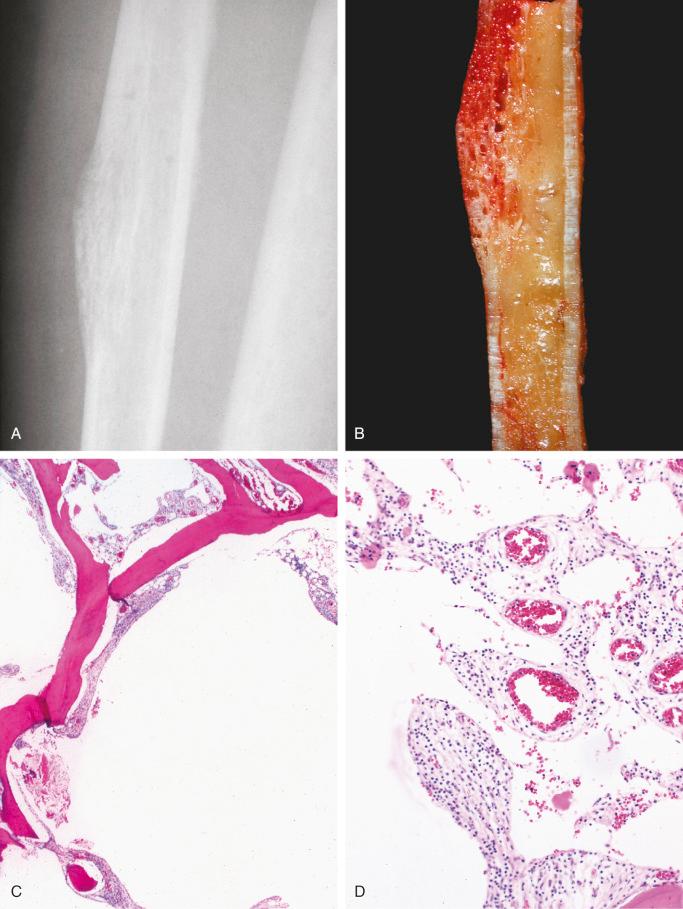
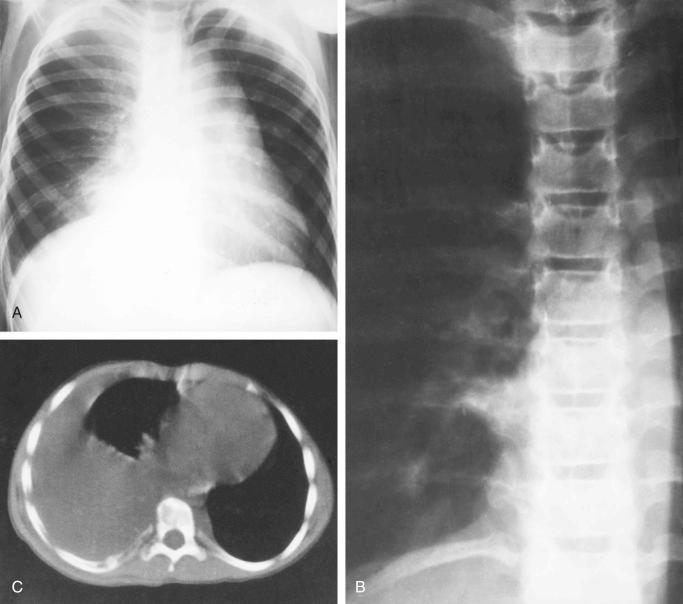
Classification of skeletal angiomatoses into distinct clinicopathologic entities is based on their clinical behavior (aggressive versus nonaggressive) and patterns of skeletal involvement (regional versus disseminated) ( Table 13-1 ). Regional angiomatosis involves one or several bones of the same anatomic region (e.g., spine, shoulder, knee) ( Figs. 13-13 to 13-18 ). Disseminated generalized angiomatosis, also referred to as cystic angiomatosis, is a generalized multifocal disorder that predominantly involves the trunk bones. Aggressive angiomatosis, or massive osteolysis, is a peculiar form of angiomatosis that progressively destroys (lyses) the affected bone or bones.
| Type of Angiomatosis | Anatomic Distribution |
|---|---|
| Nonaggressive | |
| Regional | Involvement of one anatomic region (one or several bones) |
| Extraskeletal angiomatosis may be present | |
| Disseminated (cystic angiomatosis) | Disseminated multifocal involvement predominantly affecting trunk bones |
| Extraskeletal angiomatosis (soft tissue or visceral) may be present | |
| Aggressive | |
| Massive osteolysis (Gorham's disease) | Regional involvement predominantly affecting trunk bones |
| Aggressive clinical behavior with progressive bone destruction | |
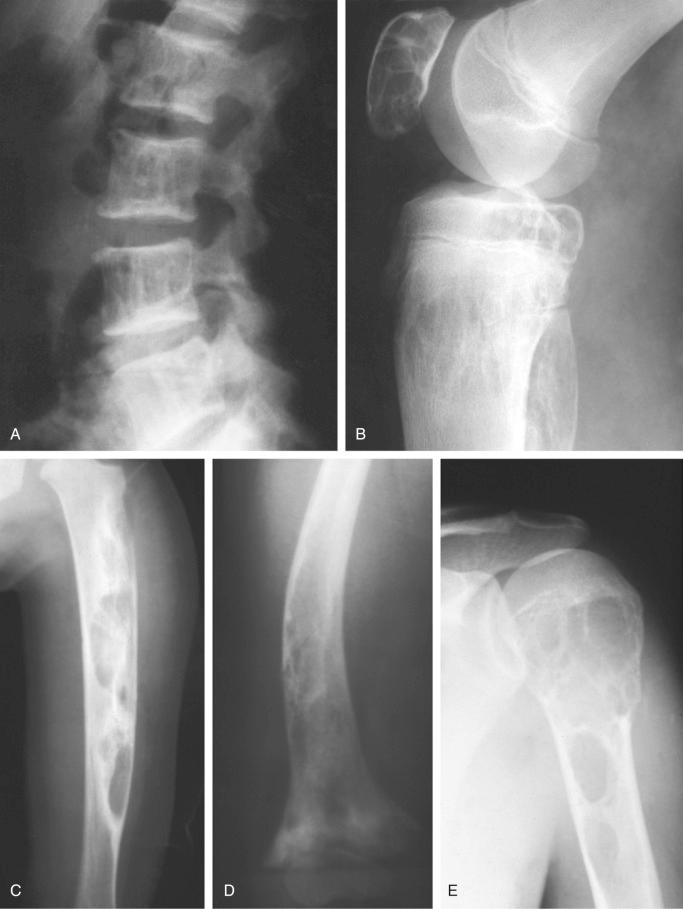
The term cystic angiomatosis is applied to extremely rare conditions of disseminated multifocal hemangiomas in the skeleton. The bone involvement may be accompanied by soft tissue and visceral hemangiomas. The sites of extraskeletal involvement include soft tissue, lung, liver, and particularly spleen. The disease is probably congenital and sometimes is clinically evident during the first decade of life. Most cases are recognized in the first three decades of life. The condition can be asymptomatic and is often detected incidentally in radiographs obtained for other reasons. The typical age of diagnosis and most frequent skeletal sites of involvement are presented in Figure 13-19 .
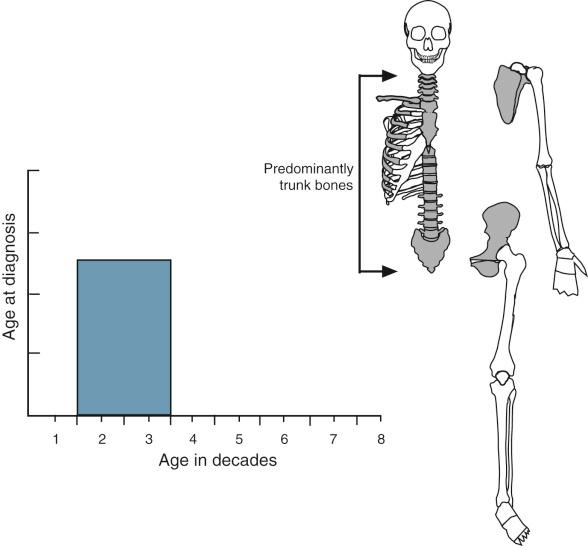
The disorder preferentially affects the trunk and occasionally cranial bones ( Figs. 13-20 to 13-23 ). Radiolucent lesions with a soap-bubble or honeycomb appearance are present in the skull, spine, ribs, and pelvis. The disease tends to spare the acral appendicular skeleton. As mentioned, the lesions are typically radiolucent but rarely sclerotic. In rare instances, the disorder is manifested on radiographs as disseminated osteoblastic lesions that mimic osteoblastic metastases.
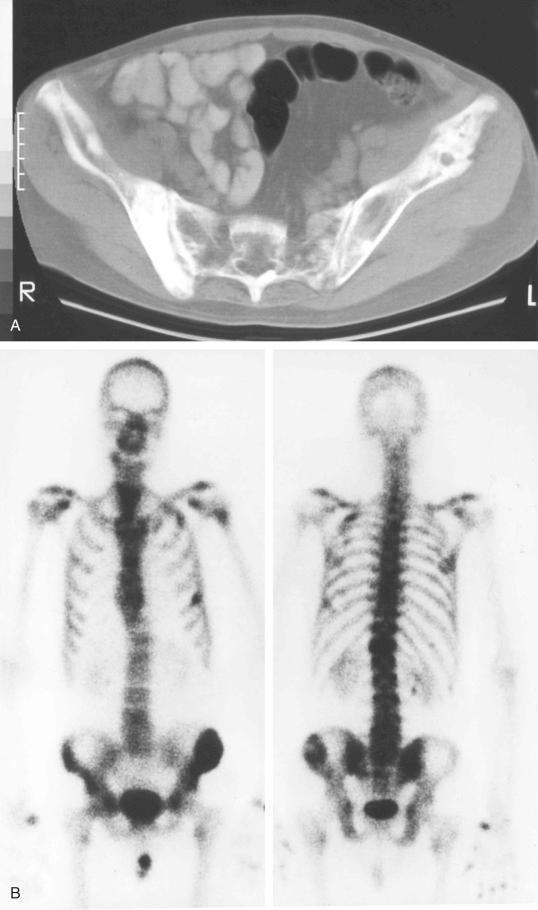
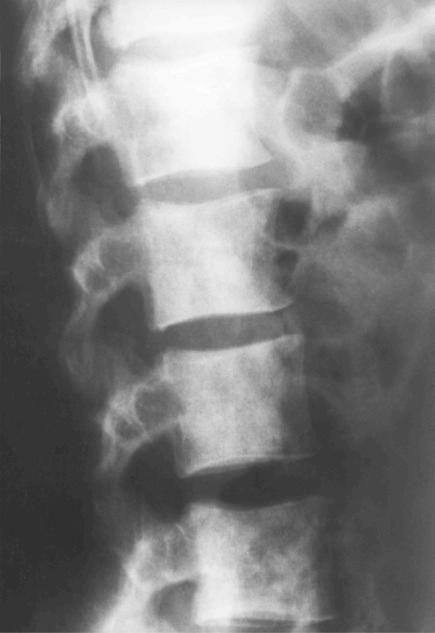
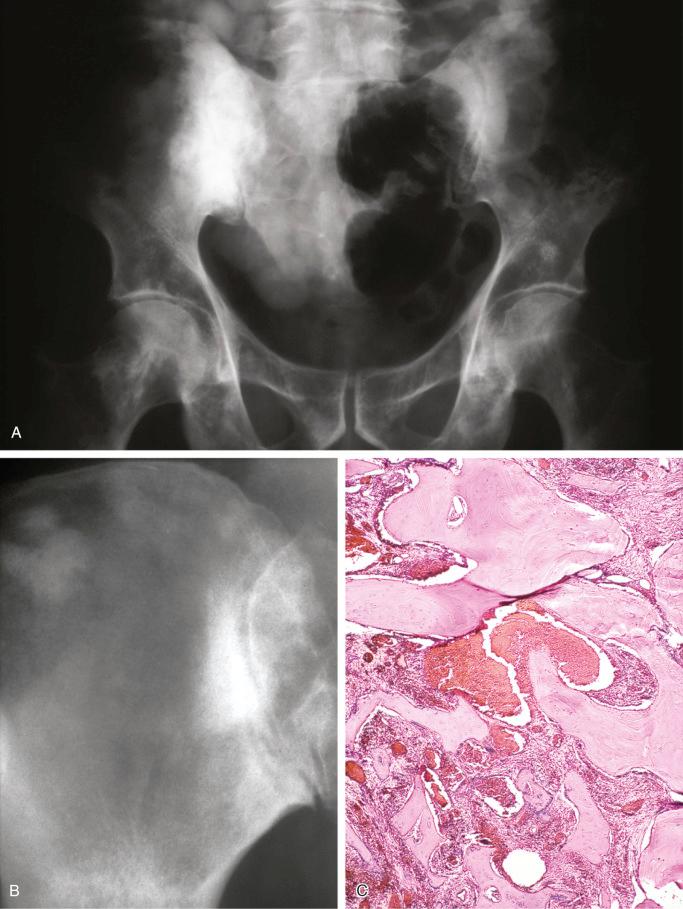
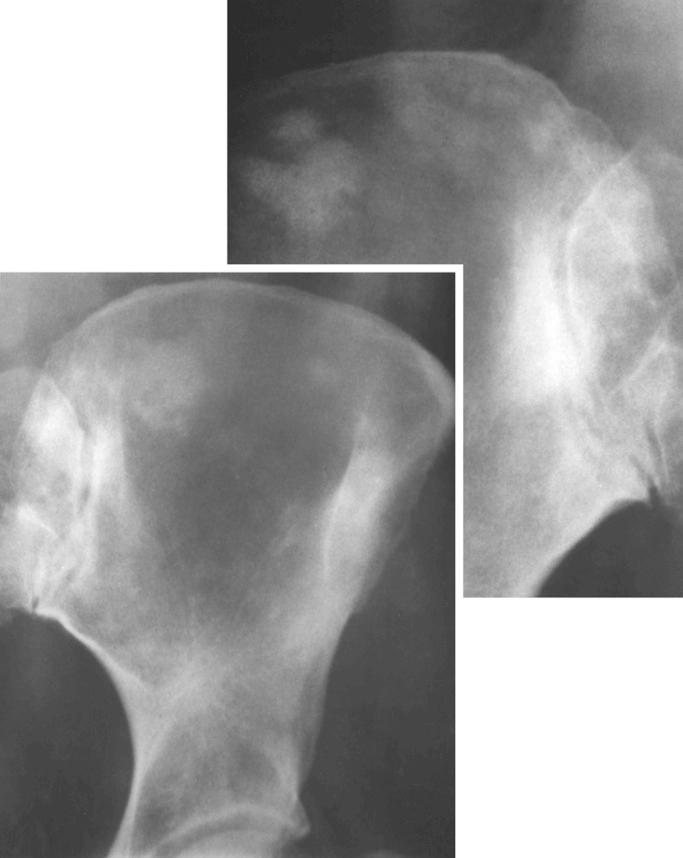
Microscopically, the lesions consist of hemangiomas that are predominantly cavernous ( Fig. 13-22 ). Usually, an admixture of dilated lymphatics is also present ( Fig. 13-24 ). In fact, some of the foci may be composed entirely of lymphatics. Foci composed of small capillary vessels can also be found. Some foci can be accompanied by prominent new reactive bone trabeculae that occasionally can dominate the lesion ( Fig. 13-24 ). In the sclerosing variant of skeletal angiomatosis, individual vessels can be surrounded by thick sclerotic bone ( Fig. 13-25 ).
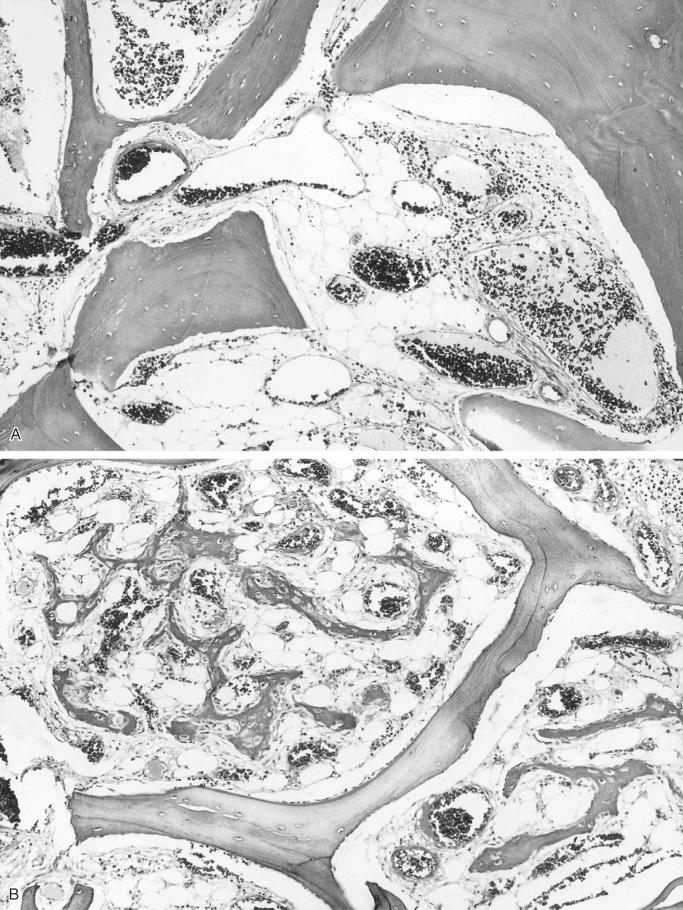
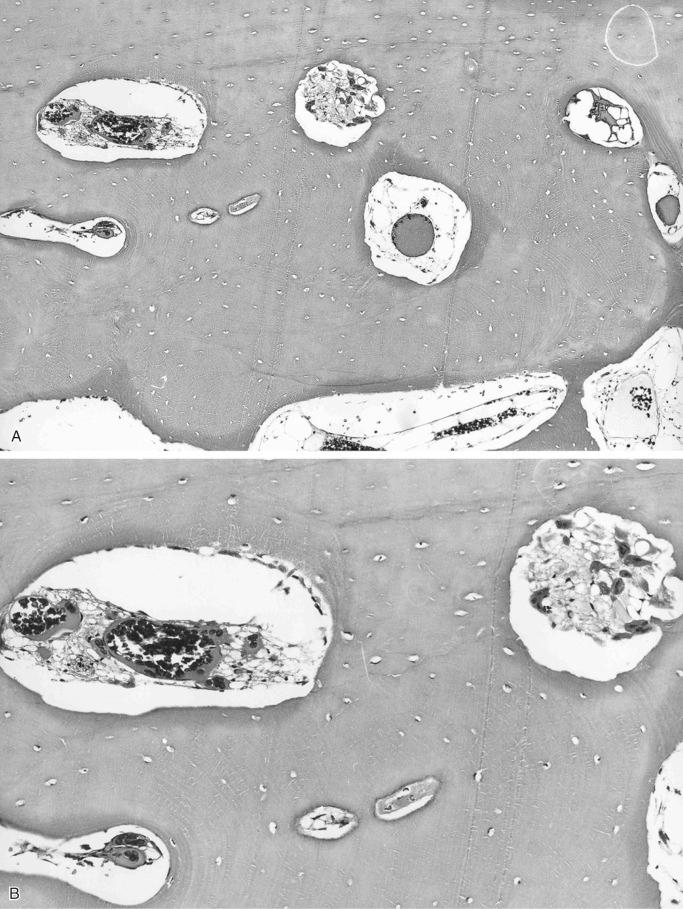
On radiographs, lytic lesions may be seen to contain some residual lamellar bone and foci of reactive woven bone. Blastic lesions contain prominent, thickened bone trabeculae of mature lamellar bone with areas of woven bone rimmed by osteoblasts. Features of osteoclastic resorption can be present in lytic and blastic lesions. It has been noted that the sclerotic lesions occur most often in older patients. Evaluation of serial radiographs in this disorder has shown that increasing osteosclerosis can be an age-related phenomenon in angiomatous foci that are originally lytic. It may be that the lesions spontaneously heal or regress and that this process is accompanied by sclerosis. The skeletal lesions in this disorder are usually stable or may even regress. Fatal complications (i.e., internal bleeding) are caused by visceral lesions. Rare cases of angiosarcoma arising from skeletal angiomatosis have been described.
Massive osteolysis, also referred to as disappearing or phantom bone disease, was described in 1954 by Gorham et al. One year later, Gorham and Stout established the fact that a peculiar clinically aggressive form of angiomatosis was responsible for this syndrome. The peak age incidence and most frequent sites of skeletal involvement are shown in Figure 13-26 . The disease usually affects children or young adults. It is sporadic, without evidence of hereditary transmission, and has no sex predilection. Usually, it involves the shoulder and hip areas and starts in the trunk bones, and it may separately involve several bones in the same region. In the appendicular skeleton, the proximal parts of the extremity bones—the proximal humerus and femur—are typically involved.
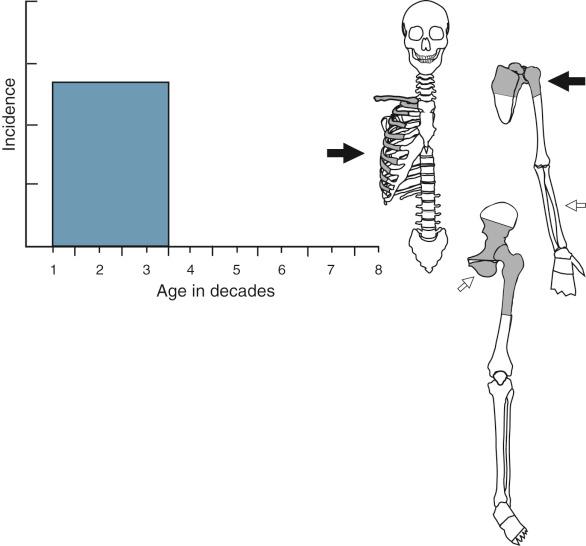
Microscopically, the vascular changes in Gorham's disease represent hemangiomas, lymphangiomas, or a combination. They are indistinguishable from ordinary, nonaggressive angiomatoses and represent a complex network of dilated, thin-walled capillaries growing in the marrow spaces. The active lesions are purely vascular, and the osteoclastic resorptive activity can be seen near the advancing edge. Stabilization of the lesion is associated with an increased amount of intervening connective tissue. On radiographs, massive osteolysis appears as lytic lesions that progressively involve the affected bones and eventually obliterate the cortical and cancellous architecture ( Figs. 13-27 and 13-28 ). The dilated cystic spaces can be seen grossly ( Fig. 13-29 ). Late lesions can be predominantly fibrous. The process tends to stabilize spontaneously. In some cases, extensive involvement of the chest wall (ribs) is associated with pleural effusion and severe pulmonary compromise, which can lead to a fatal outcome.
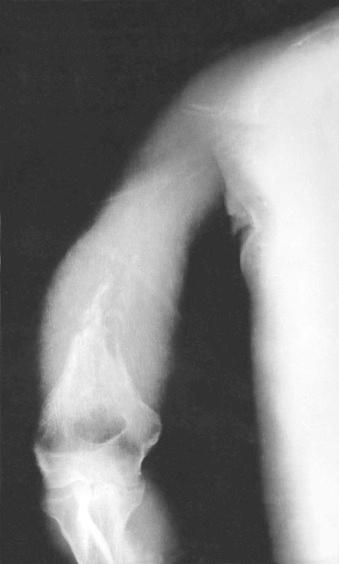
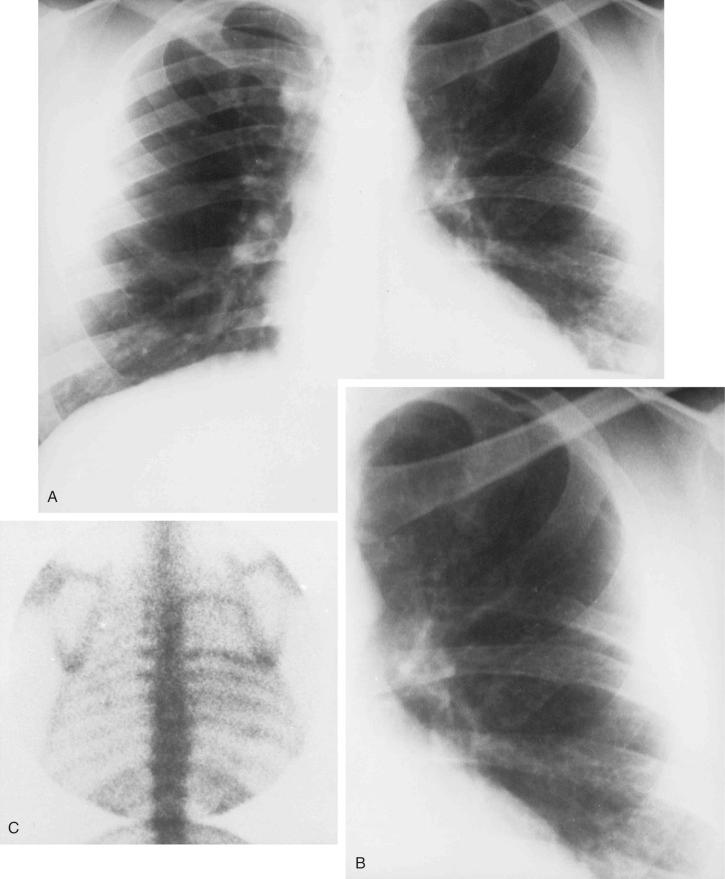
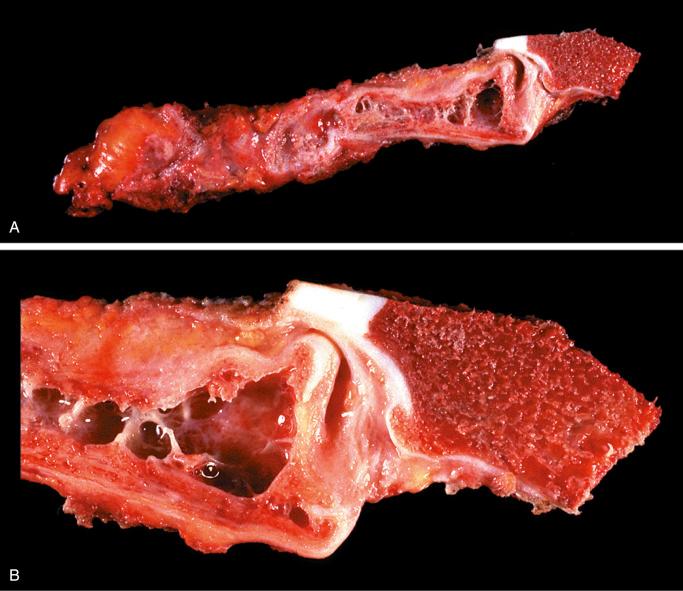
Because the clinical course of massive osteolysis is variable and unpredictable, the choice of a particular method of therapy is fraught with uncertainty. In fact, any histologically benign angiomatosis of bone or soft tissue may occasionally behave clinically as a slowly progressive disorder that eventually compromises the function of the affected organ. In such instances, major resection procedures including amputation may be required in order to control the process. Surgical resection, embolization, radiation therapy, steroids, and more recently, interferon alfa have all been used in cases showing progression.
Vascular malformations are developmental in nature and typically grow proportionally with the host. They are classified similarly to vascular neoplasms as of arterial, venous, or capillary in nature. They often manifest arteriovenous shunting. They are frequently complicated by vascular ectasia and thrombosis. They range from superficial varicosities to large, deep masses that infiltrate soft tissue and may involve large portions of the body ( Fig. 13-30 ). They are predominantly soft tissue lesions and their involvement of the skeleton is rather secondary. These conditions are best diagnosed in correlation with clinical presentation and radiographic imaging data.
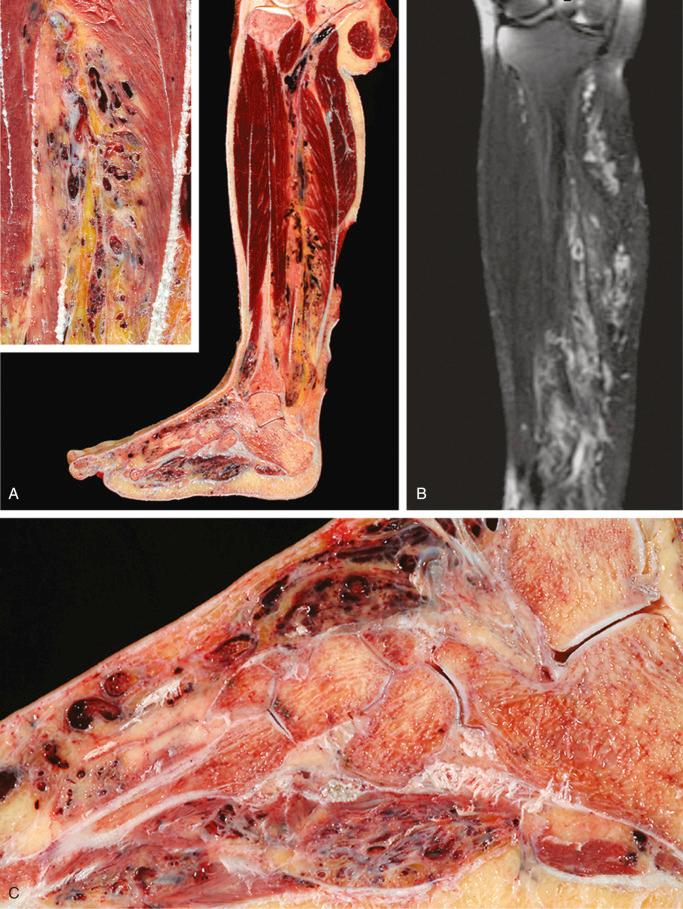
The glomus body is a form of arteriovenous anastomosis that plays a role in thermal regulation. It is distributed throughout the body in the reticular dermis but is most frequently seen in the subungual region. The normal glomus body consists of an afferent arteriole that branches into two to four connecting arterioles. The arterioles have thick segments surrounded by concentric layers of modified perivascular smooth muscle cells. These segments are called Sucquet-Hoyer canals and consist of arteriovenous anastomosing vessels connected with efferent veins ( Fig. 13-31 ). The glomus tumor was described in 1924 by Masson, who linked this peculiar neoplasm to a normal glomus body and proposed that in some cases it may represent a hyperplasia of perivascular cells rather than a true neoplasm. Normal glomus bodies can be found within the bones and can be the source of an intraosseous glomus tumor ( Fig. 13-32 ).
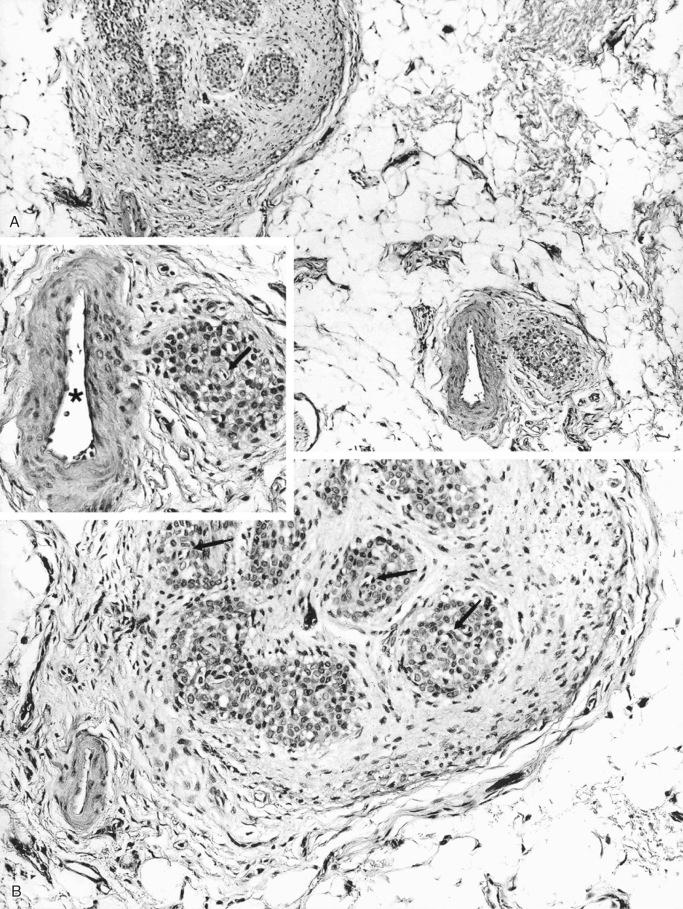
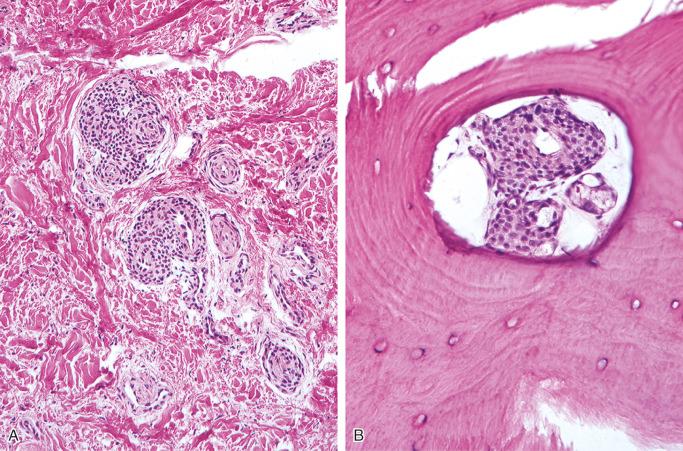
Glomus tumor is a rare, benign distinctive neoplasm composed of vascular channels and modified perivascular muscle cells that recapitulate the structure of a glomus body.
Glomus tumors are extremely rare lesions, and most are diagnosed in patients between ages 20 and 40 years. The single most common site is the subungual region of the fingers. Other common sites include the pelvis, wrist, forearm, and foot. They also can occur in the tip of the coccyx, where they arise from the glomus coccygeum. In rare instances, they may originate in the deep organs without apparent association with normal glomus bodies. The subungual lesions typically erode the underlying distal phalanges. The second most frequent location is in the subcutaneous tissue. Intraosseous glomus tumors are extremely rare, and only single cases have been reported in the literature. Most of these reports describe lesions that were completely embedded in the distal phalanges. Others have been described as periosteal lesions in long bones. In our opinion, the possibility that some of these lesions secondarily erode the bone cannot be completely ruled out. Exceptional cases of glomus tumor arising in other bones such as the proximal phalanx, tibia, ulna, and pelvis have also been reported. The peak age incidence and most frequent sites of skeletal involvement are shown in Figure 13-33 .

Become a Clinical Tree membership for Full access and enjoy Unlimited articles
If you are a member. Log in here